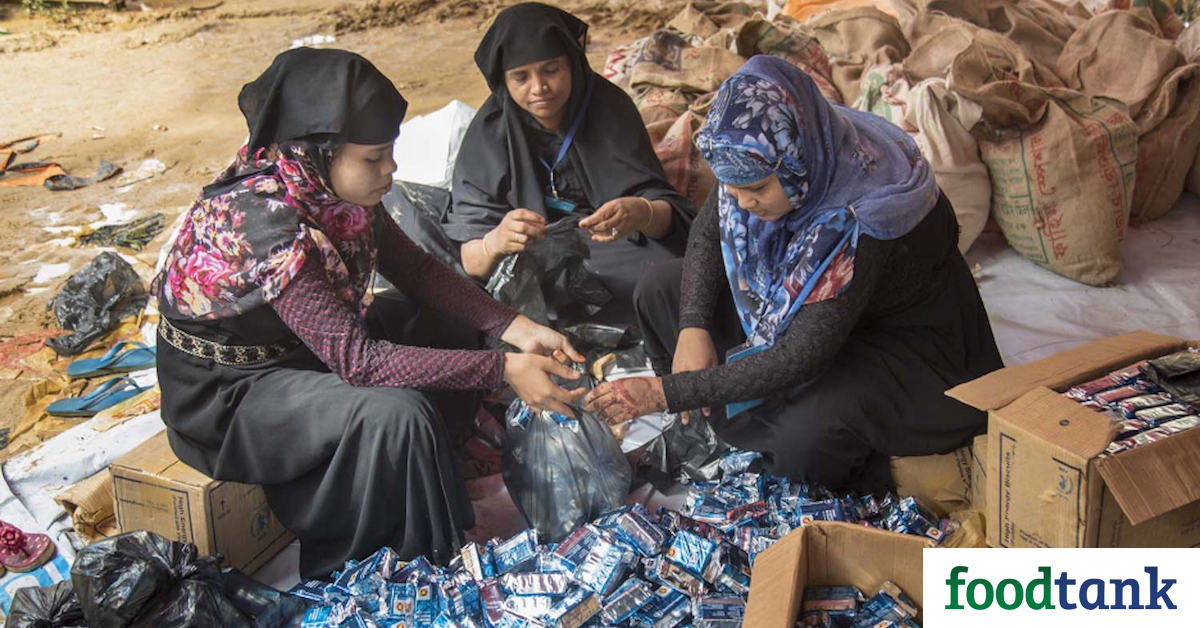
Every year, relief organizations deliver millions of metric tons of food across the globe. Most humanitarian emergencies arise in areas torn by armed conflict or natural disasters. They are complex operations with many logistical challenges. Some of the food is shipped internationally, some is procured locally, all of it is packaged in billions of polypropylene bags, plastic bottles, cardboard boxes, or aluminum wrappers.
“Adequate packaging can protect our food from suffering mechanical damage while it’s being loaded, offloaded, transported on bumpy roads or dropped from a plane,” says Carole Manceau, World Food Programme (WFP) Food Safety & Quality Unit’s packaging expert. “It can also preserve its quality in difficult environmental conditions — extreme temperatures, humidity, dust — that could affect its shelf life.”
To avoid food losses and simplify distributions, it is understandable that humanitarians use small units of aluminum or plastic wrappers. However, once the food is distributed, what happens to these wrappers? The purpose of emergency food assistance is to save lives, and environmental footprint is not the priority of humanitarian organizations. Once opened, the majority of humanitarian food packaging therefore becomes waste, and very often ends up burned or in a landfill.
Every year food assistance operations generate tens of thousands of tons of packaging waste, enough to fill stadiums. This is substantial source of pollution as plastic and aluminum biodegradation takes centuries, and it should not be a burden for the countries receiving assistance.
In December 2020, in a speech on climate action, the UN Secretary General called for the world to “make peace” with nature. From January 1 2021, the European Union banned the export of non-recyclable plastic to developing countries. Humanitarian actors are guided by the “do no harm” principle, under which they must mitigate the negative impact their action may have on the populations they serve, this includes negative environmental impact.
Is the humanitarian community addressing this challenge? What more could be done?
The issue has been acknowledged by the humanitarian sector in recent years, and new policies to improve sustainability of the supply chain are being drafted. For production and procurement some agencies are trying to use biodegradable or recycled materials. For distribution, bulk packaging is preferred when operationally feasible. Packaging is sometimes designed to be reused, repurposed, for example rice sacks are often used as bags, plastic bottles as pots to grow herbs. Once packaging turns into waste, some initiatives exist to collect and recycle it.
The humanitarian sector started to shift its mindset to a circular economy approach whereby waste is not problem to solve, a negative externality to correct, but an opportunity to create value.
In regions where recycling infrastructure are available, there is a market for empty plastic bottles and used cardboard. Scrap dealer networks can buy some of the waste generated by humanitarian food packaging. At global scale, this could represent millions of dollars of revenue for the people assisted, and an opportunity to develop the waste value chain for local stakeholders.
Even in contexts where food packaging cannot be sold for recycling, humanitarians could use it to create livelihoods, especially in refugee camps where resources are scarce and job opportunities are hard to find. Engineers Without Borders is working in Ethiopia to turn plastic waste into washing basins and building materials. The World Food Programme is working in Bangladesh to turn aluminum wrappers into reusable bags and in Kenya to recycle food sacks into new bags used on the local market. These pilot projects need to be encouraged and replicated when successful.
“When designing humanitarian waste management projects, we need to focus on innovative solutions that are suitable for local contexts – those that are affordable, low tech and easy to maintain – but also scalable and replicable to generate large scale benefits. Too often the environmental impact of humanitarian action is ignored, even though it creates long lasting damage to the same communities we’re trying to help. We should work towards incorporating sustainability into all our activities, and with the help of the private sector, research institutions and government, turn it into an opportunity, rather than a trade-off,’’ Emanuela Cattaneo, WFP Regional Environmental Adviser for East Africa, tells Food Tank.
Even though mentalities are changing, and new systems are put into place, donor organizations will have to think about ways to encourage humanitarians to reduce their environmental footprint, but also invest more waste management which is very often under-funded. Food assistance operations can be designed to include environmental sustainability from the onset, not only from a procurement and supply chain point of view, but also as an opportunity to deliver better assistance.
Photo courtesy of WFP/Saikat Mojumder
Join the Conversation:
"assistance" - Google News
June 18, 2021 at 02:00PM
https://ift.tt/3q68M0W
Reducing the Environmental Footprint of Food Assistance – Food Tank - Food Tank
"assistance" - Google News
https://ift.tt/2Ne4zX9
Shoes Man Tutorial
Pos News Update
Meme Update
Korean Entertainment News
Japan News Update
Bagikan Berita Ini














0 Response to "Reducing the Environmental Footprint of Food Assistance – Food Tank - Food Tank"
Post a Comment